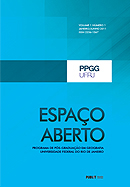Map as Conceived Space: a Critical View at the Cartographic Representation of Religious Buildings in the Brazil Official Mapping
DOI:
https://doi.org/10.36403/espacoaberto.2024.59612Keywords:
Lefebvrian Triad, Map, Cartographic Representation, ReligionAbstract
Humanity has always portrayed its space through maps, transforming them into an important tool of its graphic representation, providing a range of interpretations
and readings. Among the different elements that make up the space, religious buildings are represented on the maps through a Christian look of the public agent holding legal
power, even with the resources made available by new technologies, this look has never undergone an inclusion process. This article proposes a reflection on the construction of a conceived space – official map standardized by the government – without considering the day-to-day reality and the socially produced spaces with a sacred character or practices of different religious denominations and their concealment/erasure in the
cartographic regulations in force in the country.
Downloads
Downloads
Published
How to Cite
Issue
Section
License
Copyright (c) 2024 João Bosco de Azevedo, Adriene dos Santos Duarte, Flávia Felix da Silva, Letícia de Carvalho Giannella

This work is licensed under a Creative Commons Attribution-NonCommercial-ShareAlike 4.0 International License.



